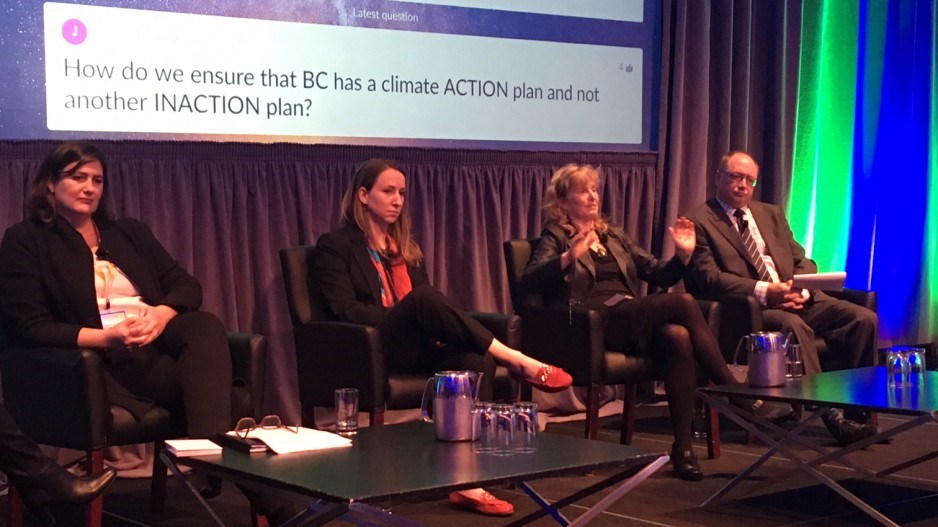Sometime in the next week or two, the B.C. government is expected to make public its new climate action plan, which is being rebranded as a "clean growth plan" that is both a climate change strategy and an energy plan.
While the details are still under wraps, government officials were giving some broad stroke previwes at the Generate 2018 conference this morning.
Dave Nikolejsin, deputy minister of Energy, Mines and Petroleum, hinted that there’s something in the plan for the clean energy sector in B.C.
“I think there’s going to be things in there that this crowd will probably like,” Nikolejsin told a Generate 2018 plenary session Wednesday November 28.
The theme of this year’s conference is energy transformation through electrification.
Federally, an energy transition plan was developed by the Generation Energy Council. Merran Smith, executive director for Clean Energy Canada, is the council’s co-chairperson.
She said the plan has two main goals: transition Canada’s energy to cleaner sources of power, and to “clean up our oil and gas sector so that we are carbon and cost competitive.”
“Using oil and gas is still going to be part of the Canadian landscape for the next few decades,” Smith said.
The goal will be to reduce emissions from fossil fuels through things like electrification, methane emissions reductions and various clean-tech solutions.
One of the goals is to produce 90% of Canada’s electricity with “clean” zero-carbon power.
“Here Canada has a huge competitive advantage,” Smith said. “We are already at 79% zero emission electricity.”
Canada has an abundance of hydro power, which may make it easier for some provinces to switch off coal power plants, if better grid integration enables the provinces to share power more easily.
Colleen Giroux-Smith, vice president of corporate relations for Innergex Renewable Energy, said that the Generation Energy plan is agnostic on what types of power generation should replace coal power in provinces like Saskatchewan and Alberta. That was partly in recognition of the fact that a lot can change over the next two decades.
“We don’t know that today’s leader is what the leader is going to be in 10 years (or) what it’s going to be in 20 years,” she said.
B.C.’s climate change goal is a greenhouse gas emissions reduction of 30% below 2007 levels by 2040.
Bobbi Plecas, deputy minister of Environment and Climate Change, said that includes a 40% reduction in emissions from transportation, of which the province’s electric vehicle incentives is a big part.
One of the pieces of B.C.’s new climate change strategy was already announced last week – a zero emissions vehicles mandate. The aim is to have 10% of all cars sold in B.C. by 2025 to be low or zero emission cars (electric or hydrogen), and no internal combustion engine cars by 2040.
Plecas said battery technology is not at the point that would allow conversion to electric for heavy duty trucks and other heavy duty vehicles, so the government will look at ways to help those sectors to convert to other lower emission fuels, like LNG or hydrogen.
Another component of emissions reduction is energy conservation, some of which is to be accomplished through retrofits that improve home insulation. Plecas pointed to the provincial government’s $1 billion spending plan for social housing as one of the tools.
“A full one-third of that money will go for energy retrofits,” Plecas said.
The big challenge for B.C. is fitting an LNG industry into the provincial climate change plan.
Nikolejsin said simply providing electricity to the natural gas fields to allow gas processing plants to run on electricity instead of natural gas results in a potential GHG reduction that is “massively large.”
Some natural gas plants in B.C. already run on hydro power, and more will eventually be able to run on electricity with the completion of the Peace River Electrical Supply (PRES), which is already under construction.
“There’s things already going on but there’s opportunity to do a lot more,” Nikolejsin.
Nikolejsin fielded questions about Site C dam and BC Hydro’s load forecasts.
While one camp slams BC Hydro for making load projections that are too low to justify Site C, the other camp says they are not high enough to factor in the increased demand from an LNG industry and wider adoption of electric vehicles.
Nikolejsin agreed that, eventually, B.C.’s electricity demand will increase with greater EV adoption. But he said that isn’t expected to really ramp up until the second half of the 2020s.
“Over time, absolutely, it’s a massively big impact,” he said. “But in the near term, it’s not that big of a load and the grid is well supplied.”
As for the LNG industry, Nikolejsin said the first priority is electrifying the upstream.
But should LNG Canada decide to move ahead with a second phase that would add an additional two processing units, he suggested that those new plants might have to use electricity (e-drive) rather than natural gas for the liquefaction process.
“Once a project’s built, it’s not going to change, but for the next phase…we are really, really working hard with people who want to build additional LNG in B.C. to say ‘You gotta fit in the climate plan,’ and that drives them to this conversation about e-drives.”




